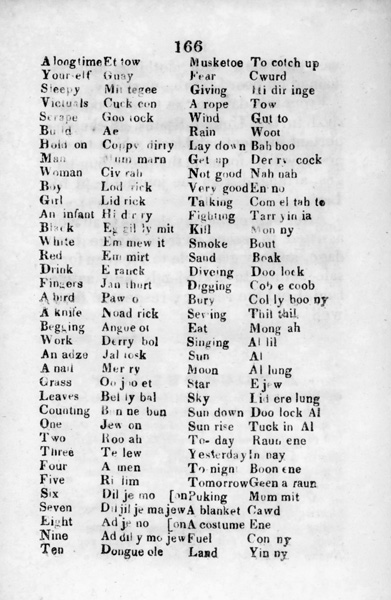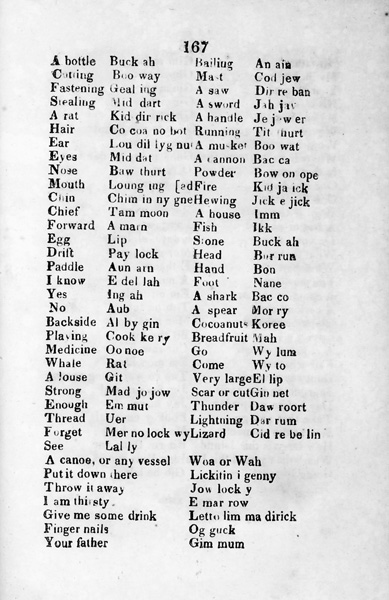
LAY AND HUSSEY’S MARSHALLESE VOCABULARY
One of the most remarkable achievements of the two marooned Globe survivors was the acquisition of a command of the Milians’ language that was so good that the natives themselves commended the two seamen for their fluency. The soundest evidence of their grasp of the language is the vocabulary list they assembled after their rescue—it had to be after the rescue since nothing to write with would have been available on Mili.
Horatio Hale, ethnographer and philologist with the United States Exploring Expedition, 1838–1842, records that “On their [Lay’s and Hussey’s] arrival at Oahu, the Rev. Mr. Bingham, missionary at Honolulu, took down a vocabulary of such words of the native language as they could remember.” Bingham’s purpose was to be ready for eventual proselytizing in Micronesia. Hale learned of this study of Marshallese directly from Bingham, who analyzed forms, orthography, and pronunciation of the words in a brief study, which Hale draws on. Hale says that Bingham said of his study, “it is very imperfect,” a judgment that Hale immediately qualifies by saying, “but the deficiencies are such as must properly be referred to a limited knowledge of the language on the part of the two men, who could have acquired little more than a smattering of the most common idioms, with such words as were needed in the daily intercourse with the natives.” This opinion is intolerable, especially when coming from a philologist, who could see evidence of the two men’s fluency in the accounts of easy communication in their Narrative and in Paulding’s Journal (both of which Hale indicates that he was familiar with), and who could also see that the range of vocabulary in the Lay and Hussey list went far beyond everyday common idioms, and who could not fail to realize that the words recorded by Lay and Hussey on the list in their Narrative or the ones jotted down by Bingham are only randomly chosen examples out of a much larger active vocabulary.
Bingham’s own word list is reprinted in Hale’s publication (431–34). It is shorter than Lay and Hussey’s list; the two lists overlap only partially. Probably Lay and Hussey could have made their list much longer (and possibly did for Bingham) but wanted to give the readers of their Narrative just a sampling of words that would convey an impression of the look and sound of the language. Whether Bingham could have had access to other sources from which to study the Micronesian language study (like the word list in the second volume of Kotzebue’s A Voyage Around the World [1821]) is unclear. He did not discuss the language with Hale until a decade after meeting with Lay and Hussey; what Hale prints of Bingham’s grammar and word list could have come from considerable study since meeting the two seamen, but the two seamen were very likely his first instructors. Lay and Hussey’s list has been compared with The Marshallese-English Dictionary (Abo in Bibliography) and has been discussed with Alfred Capelle, one of the editors of the dictionary; Lay and Hussey get high marks for accuracy. The list of words sheds light not only on the two men’s knowledge of the language in general but also on the subjects that made up the discussions they held with the natives.
The following are excerpts from Lay and Hussey’s “A VOCABULARY Of Words and Phrases, used by the natives of the Mulgrave Islands, with their definitions and so spelt and divided in syllables as to give the Reader a very clear understanding of the pronunciation.”

A VOCABULARY Of Words and Phrases, used by the natives of the Mulgrave Islands, with their definitions and so spelt and divided in syllables as to give the Reader a very clear understanding of the pronunciation.
